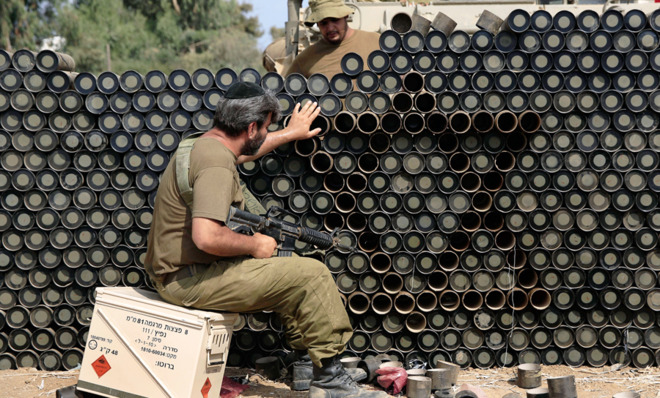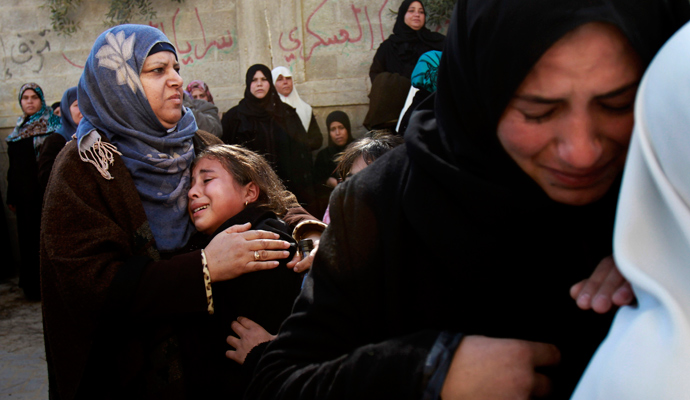Gaza: One war, two realities
Stories from both sides on the turmoil in the Middle East

The terror of Hamas's secret tunnels
By Jodi Rudoren
The curved concrete top of the tunnel grazes the dark-brown buzz cut of Lt. Col. Oshik Azulai, putting the ceiling 5 feet and 7 inches above the sand floor. The walls are about 30 inches apart — wide enough for two people to squeeze past each other, unless both are in body armor. It is cool in the tunnel, 46 feet under, and dark, of course. Cellphones do not work.
The Week
Escape your echo chamber. Get the facts behind the news, plus analysis from multiple perspectives.

Sign up for The Week's Free Newsletters
From our morning news briefing to a weekly Good News Newsletter, get the best of The Week delivered directly to your inbox.
From our morning news briefing to a weekly Good News Newsletter, get the best of The Week delivered directly to your inbox.
Azulai, deputy commander of the Israeli military's Southern Gaza Division, said this tunnel stretched four fifths of a mile into Israel, next to a field filled with watermelon, ripe but unpicked because of the war. It ended about 600 yards from Kibbutz Ein Hashlosha, a rural enclave of 325, but was unfinished: Unlike the tunnels used to infiltrate Israel from Gaza in recent days, this one still had electric lines along the wall and carriage tracks used to ferry out dirt.
Destroying such tunnels was the stated goal of Israel's ground invasion of Gaza, which began July 17. But 11 days into the mission, and after Israeli officials say they have found 31 tunnels and destroyed 15, Palestinian militants again penetrated underground into Israel on Monday evening and confronted soldiers in a staging area. Multiple soldiers were killed, a senior military official said, as was at least one of the men from Gaza.
"We will not complete the operation without neutralizing the tunnels, the sole purpose of which is the destruction of our civilians and the killing of our children," Prime Minister Benjamin Netanyahu of Israel declared in a televised address afterward. "It cannot be that the citizens of the state of Israel will live under the deadly threats of missiles and infiltration through tunnels — death from above and death from below."
Tunnels have lurked in the dark spaces of Israeli imagination at least since 2006, when Hamas, the militant Islamic movement that dominates Gaza, used one to abduct an Israeli soldier.
A free daily email with the biggest news stories of the day – and the best features from TheWeek.com
Far more than the rocket barrages that have sent Israelis scrambling for shelter throughout the bloody weeks-long battle, the tunnel attacks — Monday's was the sixth of the current conflict — have shaken the collective psyche and stiffened resolve to continue or even expand the fight.
In cafés and playgrounds, on social media sites and in the privacy of pillow talk, Israelis exchange nightmare scenarios that are the stuff of action movies: armed enemies popping up under a day care center or a dining room, spraying a crowd with machine gun fire or maybe some chemical, exploding a suicide belt or snatching captives and ducking back into the dirt.
"It takes us a little bit to our childhood fairy tales of demons," said Eyal Brandeis, 50, a political scientist who lives on Kibbutz Sufa, a mile from where 13 militants emerged from a tunnel at dawn July 17. "It's a very pastoral environment I live in — the quiet, the green grass, the trees. It's not a pleasant thought that you sit one day on the patio drinking coffee with your wife and a bunch of terrorists will rise from the ground."
An Israeli military spokesman said that in the tunnels uncovered so far, soldiers have found more than 70 side shafts. Inside the Ein Hashlosha tunnel, they picked up potato-chip bags dated as recently as February. Elsewhere, there were dates, water, and crackers; rocket-propelled grenades and automatic rifles; small rooms for sleeping or hiding; a kidnapping kit of tranquilizers and plastic handcuffs; Israeli Army uniforms; and a Bosch drill used for digging the tunnels that Azulai described as "a very good one."
"It's like a subway under Gaza," he said.
Israeli experts said each tunnel would take up to a year and cost up to $2 million to build, involving dozens of diggers working by hand and with small electric tools. The military has known about the tunnels since at least 2003 and had a task force studying them for a year, but was nonetheless stunned at the sophisticated network it found.
Intelligence officers track the tunnels by watching for piles of dirt and men disappearing into buildings for days, as well as through communications equipment used underground, according to several army veterans. But radar designed to detect oil or gas far deeper underground, they said, has often failed to find the tunnels, which burrow through mixed soil closer to the surface that technology has not yet been able to detect.
"Most of the tools, the physical tools, don't work on this level of the ground — the physics, it's very limited," explained Brig. Gen. Shimon Daniel, who commanded Israel's combat engineering corps from 2003 to 2007 and has since retired. "This is the paradox. It's not easier. It's more difficult."
Israeli political and military leaders mention the tunnel threat nearly every time they speak, and have gained widespread international support for eliminating them. The military in recent days has distributed photographs of tunnels that troops uncovered, and videos of them placing explosives inside and blowing some up. As part of the propaganda push, the military has also invited a few journalists underground for a tour.
Azulai, 36, led the way down a huge sand-walled crater that Israel dug to get access to the Ein Hashlosha tunnel and crouched inside. It was perfectly straight; concrete blocks stood neatly side by side, topped by curved ones. Along one wall ran an iron bar supporting electric cables, including one added by the Israelis. At one point, a few blocks of concrete were missing, rough natural rock in their place. At another, a crushed dirty water bottle was stuck in the bar. There were a few splashes of green paint.
"It's very simple but very professional," Azulai said of the tunnel, which he said ran nine tenths of a mile into Gaza, ending in Khan Younis, one of the focal points of the Israeli assault.
"We don't have a base of soldiers close to here," he noted. "If they want to attack us soldiers, it's okay for us to be in battle, but they want to use these tunnels to attack women and children."
Sderot, the Israeli town of 24,000 near Gaza's northeast corner, has become a symbol worldwide after being battered by rockets from Gaza for 13 years. But it is the kibbutzim scattered along Gaza's eastern edge that are most threatened by the tunnels.
"We were feeling pretty safe before," said Ma'ayan Barkai, 34, director of Kibbutz Be'eri, where one tunnel was found over the weekend. "We knew what to do with the missiles. The tunnels, it's game changing. We can't do anything if the terrorists will come to our kindergarten. The tunnels, it's very surprising; it can hit you don't know where."
Shock and grief after Israeli air strikes
By Sudarsan Raghavan

Inside Shifa Hospital in Gaza City, amid the tumultuous rush to save lives, men pushed a gurney carrying the lifeless body of a child wrapped in a sheet. A girl in a red dress, her face covered with blood, walked in a daze past the dead and the nearly dead.
"Oh, my God, what happened to us?" a man screamed, his voice somehow lifting above the din of hundreds of people who clogged the hospital's halls on Monday. They were all perhaps asking the same question.
The tragedy began at around 4:30 p.m. with an explosion on a narrow, tree-lined street in the Beach Camp neighborhood. It was the Muslim holiday of Eid al-Fitr, and children were playing outside — some on swings, some near storefronts and parked cars. Hamas militants blamed an Israeli airstrike. Israel said a Hamas mortar shell went awry. Ten residents were killed, including at least seven children.
At 5 p.m., Ahmed al-Helu was not thinking of blame, at least not yet. He was at the hospital, crying in front of his father's shattered corpse, a headless tangle of flesh and bone. He didn't notice the dead child in the sheet or the dazed girl in red passing by.
A week ago, the family home came under fire in the city's Shijaiyah enclave, where Israeli forces and Hamas militants fiercely clashed. Helu's grandmother — his father's mother — was killed in the crossfire, and the family fled to Beach Camp. The three-week-old war found them there.
"My beloved father," Helu's brother cried, standing at his white, blood-drained feet. "You are following your mother."
Moments later, the two men helped nurses place their father's corpse in a white bag. A small piece of his body fell to the floor. Ahmed picked it up, unzipped the bag, and carefully tucked it inside.
Outside the hospital's morgue, Saleh Eleyan sat on a step, his head buried in his palms. The bodies of his two sons were inside. A hospital worker came by and asked him to confirm their names, written on a sheet of paper. Afterward, silent and sobbing, Eleyan spotted a boy who resembled his sons — and hugged him hard.
An ambulance rolled by slowly. Some people peered into the back to see if a relative was inside. A hospital worker pushed an empty gurney, covered with a pool of blood, from the morgue.
Inside the morgue, the bodies of five children were stacked in a metal freezer — two on the top rack, two in the middle, and one on the bottom. Scores of angry men denounced the killings.
"It's the martyr's Eid," yelled one.
"We will not be afraid anymore of the Israelis," yelled another.
"May Allah take revenge for this," they all chanted a few minutes later.
At 6:15 p.m., hundreds of people were gathered in Beach Camp, on the street where the explosion occurred. There was a small crater in the asphalt. Buildings and a white Mitsubishi sedan were pocked with baseball-size shrapnel holes. Two torn children's slippers lay in a pool of blood.
Yayhya al-Derby, 10, remembered how he was playing with his friends on the swing set, a portable contraption set up to entertain children during Eid. He had felt tired and had gone to his house. The other children, residents said, were either on the swings or in the street when the shell or rocket struck.
"Most of them are my friends," Yayhya said, his hands shaking.
As he spoke, a woman approached. She was looking for her sister-in-law's son, Osama. He had been playing at the swings, she said. When asked her last name, she said it was al-Helu. She wasn't aware that Osama's grandfather — Ahmed's father — had been killed. And no one had the courage to tell her.
At 6:48 p.m., the men of Beach Camp carried the body of 9-year-old Mansour Hajaj to the nearby cemetery. It was opposite a house that had been reduced to rubble three days earlier by an Israeli airstrike, residents said. A portion of the cemetery was also destroyed.
As per Muslim tradition, Mansour's body was washed and shrouded in white cloth. His uncle, a medic, was used to dealing with corpses. But when he carried his nephew, he was sobbing uncontrollably.
The boy's father, Rami, was in worse shape, unable to help bury his son. But as the uncle placed Mansour into his final resting place, his father cried out, "I want to see him."
The uncle lifted Mansour and opened the shroud, revealing his black hair. His father bent down and kissed his son's head.
"May Allah take revenge for this," the mourners chanted, after Mansour was laid to rest.
By 7:10 p.m., they had filtered out of the cemetery.
"He wanted to chase happiness on Eid," Rami Hajaj said, glancing upward as if he were speaking to the heavens. "He was
just a kid."
Excerpted from articles that originally appeared, respectively, in The New York Times and The Washington Post on July 29. Reprinted with permission.
-
 5 sleeper hit cartoons about Sleepy Don
5 sleeper hit cartoons about Sleepy DonCartoon Artists take on cabinet meetings, a sleepy agenda, and more
-
 Political cartoons for December 6
Political cartoons for December 6Cartoons Saturday’s political cartoons include a pardon for Hernandez, word of the year, and more
-
 Pakistan: Trump’s ‘favourite field marshal’ takes charge
Pakistan: Trump’s ‘favourite field marshal’ takes chargeIn the Spotlight Asim Munir’s control over all three branches of Pakistan’s military gives him ‘sweeping powers’ – and almost unlimited freedom to use them